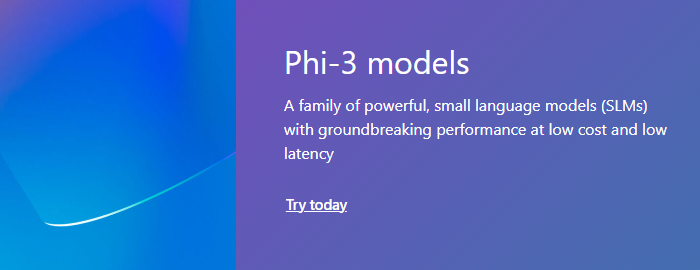The editor of Downcodes learned that Microsoft recently released a serverless fine-tuning function for the Phi-3 small language model, which will greatly simplify the process of optimizing the model for developers. Without the need to manage servers, developers can easily adjust the Phi-3 model on the Azure AI platform, lowering the threshold for use and improving efficiency. The launch of this feature demonstrates Microsoft's determination to continue to innovate in the field of AI, and also provides enterprise developers with more convenient and efficient AI solutions.
Recently, Microsoft announced the launch of serverless fine-tuning capabilities for its Phi-3 small language model. This new feature will help developers easily tune and optimize the performance of Phi-3 models without having to manage their own servers.
Microsoft launched the service on its Azure AI development platform, allowing developers to fine-tune models in the cloud without considering the complexity of the underlying infrastructure, and (initially) for free.

The Phi-3 model is a small language model with 3 billion parameters. It is designed for enterprise developers and can provide efficient performance at a lower cost. Although its number of parameters is much smaller than Meta's Llama3.1 (405 billion parameters), the performance of Phi-3 is still close to OpenAI's GPT-3.5 model in many application scenarios. Microsoft stated when it was first released that the Phi-3 model is highly cost-effective and suitable for tasks such as programming, common sense reasoning, and general knowledge.
However, the previous Phi-3 model fine-tuning required developers to set up a Microsoft Azure server or run it on a local computer, which was complex and required certain hardware. Now, through serverless fine-tuning, developers can adjust and optimize models directly on Microsoft's Azure AI platform, which not only greatly simplifies the operation process, but also lowers the threshold for use.
Microsoft also announced that Phi-3's small and medium-sized models can be fine-tuned through serverless endpoints, which means developers can adjust the model's performance according to their needs to adapt to different application scenarios. For example, educational software company Khan Academy has begun using fine-tuned Phi-3 models to optimize the performance of its Khanmigo teacher version.
However, this new feature also makes the competition between Microsoft and OpenAI more intense. OpenAI has just recently launched a free GPT-4o mini model fine-tuning service, and Meta and Mistral are also constantly launching new open source models. Major AI providers are actively competing for the enterprise developer market and launching more competitive products and services.
Official blog: https://azure.microsoft.com/en-us/blog/announcing-phi-3-fine-tuning-new-generative-ai-models-and-other-azure-ai-updates-to-empower -organizations-to-customize-and-scale-ai-applications/
**Emphasis added:**
**Serverless fine-tuning release**: Microsoft launches serverless fine-tuning functionality, allowing developers to easily adjust the Phi-3 language model without having to manage infrastructure.
? **Cost-effective Phi-3**: The Phi-3 model provides efficient performance at a low cost and is suitable for various enterprise application scenarios.
**Fierce market competition**: Microsoft's serverless fine-tuning capabilities have intensified competition with OpenAI and other AI model providers, driving industry development.
All in all, the serverless fine-tuning function of Microsoft Phi-3 model lowers the threshold for AI applications and provides developers with a more convenient and efficient model fine-tuning solution. But it also indicates that competition in the AI market will become more intense, and manufacturers will continue to launch more competitive products and services to meet the growing market demand. The editor of Downcodes will continue to pay attention to the trends in the AI field and bring you more exciting reports.